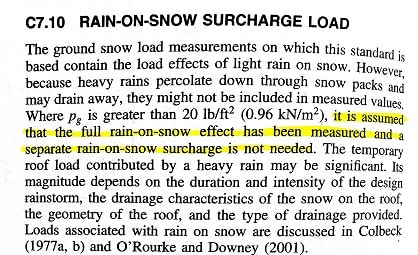A basic ponding question: As I interpret ASCE 7-16, the ponding load is treated as Rain (R in load combinations). This suggests that it does not act concurrently with Snow load. However, the commentary on sections 7.11 (Ponding Instability) states:
So, when determining the capacity of existing open web roof joists on a flat roof, are Rain and Snow considered separately (i.e. D+[Lr or S or R]) or must I consider that the deflected roof shape from snow load will fill with water?
This is an existing roof, 44" LH trusses spanning 88', built in 1961, with a dead flat roof, no parapet. My task is to determine its adequacy to carry a sizable new rooftop mechanical unit, which it cannot, so the roof will need to be reinforced in some way to carry the load from the RTU, additional drift, and possibly ponding.
ASCE 7-16 Commentary said:It is very important to consider roof deflections caused by snow loads when determining the likelihood of ponding instability from rain-on-snow or snow meltwater
So, when determining the capacity of existing open web roof joists on a flat roof, are Rain and Snow considered separately (i.e. D+[Lr or S or R]) or must I consider that the deflected roof shape from snow load will fill with water?
This is an existing roof, 44" LH trusses spanning 88', built in 1961, with a dead flat roof, no parapet. My task is to determine its adequacy to carry a sizable new rooftop mechanical unit, which it cannot, so the roof will need to be reinforced in some way to carry the load from the RTU, additional drift, and possibly ponding.

